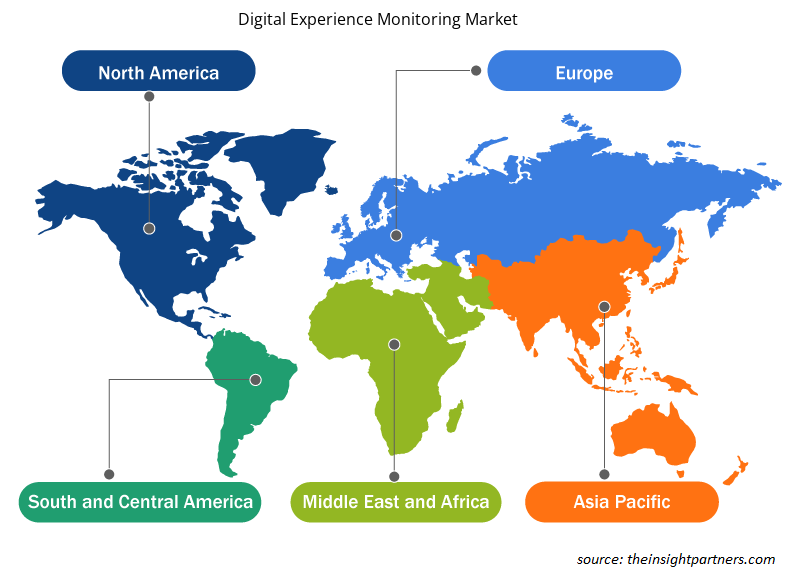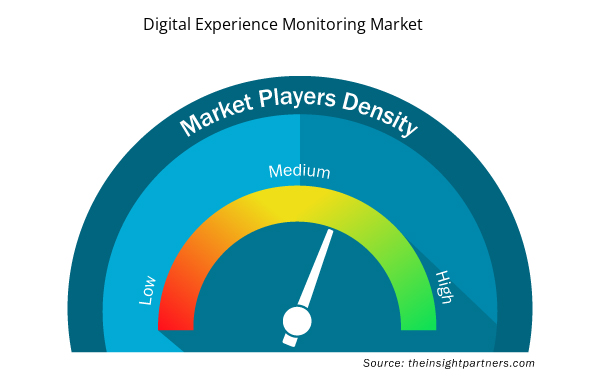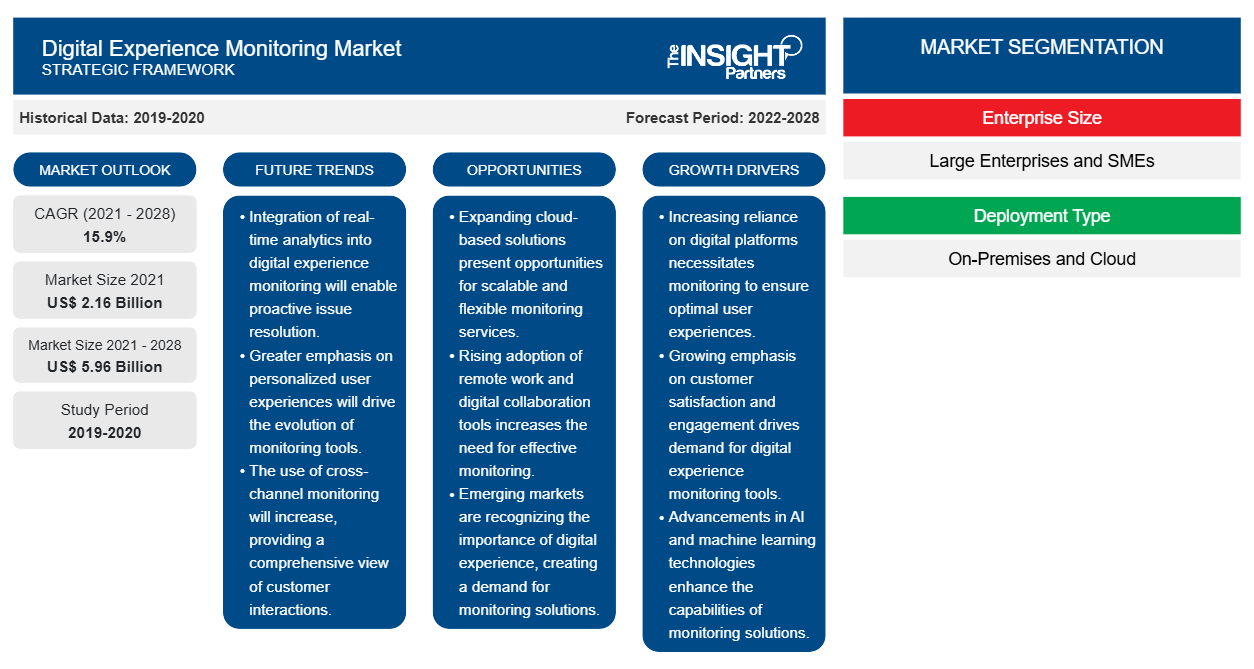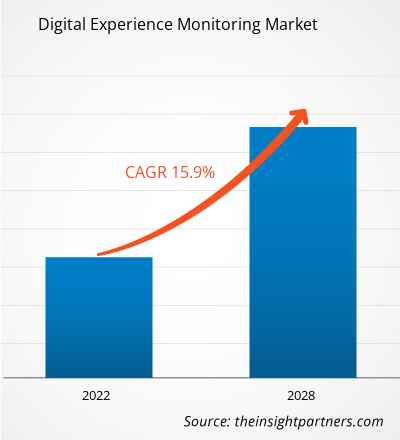Si prevede che le dimensioni del mercato del monitoraggio dell'esperienza digitale cresceranno da 2.156,71 milioni di dollari nel 2021 a 5.960,87 milioni di dollari entro il 2028. Si stima che le dimensioni del mercato del monitoraggio dell'esperienza digitale cresceranno a un CAGR del 15,9% dal 2022 al 2028.
Il monitoraggio dell'esperienza digitale (DEM) è una nuova tecnologia che le aziende stanno prendendo in considerazione come metodo per semplificare i problemi di prestazioni degli utenti, ottenendo al contempo informazioni su una gamma di tecnologie di rete con un'unica soluzione. La progressione del monitoraggio delle prestazioni delle applicazioni (APM) e del monitoraggio dell'esperienza dell'utente finale (EUEM) in una soluzione olistica che valuta l'efficacia delle applicazioni e dei servizi di un'azienda è DEM. DEM è una soluzione di monitoraggio in tempo reale che aiuta i team delle operazioni IT a risolvere tempestivamente i problemi degli utenti, garantendo al contempo che la rete non venga disturbata. Le tecnologie di monitoraggio delle prestazioni delle applicazioni (APM) e di monitoraggio e diagnostica delle prestazioni di rete (NPMD) esistenti possono essere integrate con soluzioni DEM. Se utilizzate insieme, forniscono una visione end-to-end, con DEM che fornisce informazioni sull'esperienza utente. Queste sono le esperienze che hanno l'impatto più diretto sui risultati aziendali. DEM è uno strumento di monitoraggio in tempo reale che aiuta la "macchina" della tua azienda a funzionare senza problemi, scoprendo le vulnerabilità che causano tempi di inattività o disturbi all'esperienza utente, come tempi di caricamento delle pagine scadenti, e determinando la causa sottostante delle prestazioni. Il software DEM monitora il comportamento degli utenti, il traffico e altri fattori per aiutare le aziende a comprendere l'usabilità e le prestazioni del prodotto. I prodotti DEM integrano il traffico attivo o simulato e il monitoraggio degli utenti reali per analizzare le prestazioni teoriche e l'esperienza reale dell'utente. Questi strumenti forniscono strumenti analitici per esaminare e migliorare le prestazioni dell'applicazione e del sito. Aiutano inoltre le aziende a comprendere come i visitatori navigano nel loro sito e a scoprire dove l'esperienza dell'utente finale sembra risentirne.
L'esame dei dati sulle prestazioni su dispositivi, app, infrastrutture e servizi per comprendere in che modo le interazioni degli utenti finali con la tecnologia influenzano la qualità della loro esperienza digitale è noto come DEM. L'IT può tracciare e valutare vari parametri che influenzano gli utenti, tra cui CPU, memoria, utilizzo dell'hardware, latenza, prestazioni del software e altro, utilizzando il monitoraggio dell'esperienza digitale. Queste misurazioni, che vengono raccolte costantemente dall'endpoint e abbinate all'analisi cognitiva e all'automazione, possono aiutare l'IT a diagnosticare, risolvere e persino prevedere tempestivamente i problemi senza che l'utente ne sia a conoscenza. Feedback e opinioni possono anche indicare elementi che le statistiche dell'endpoint non possono catturare. Le soluzioni di monitoraggio dell'esperienza digitale vanno oltre il tipico monitoraggio delle prestazioni di rete e applicazione per scoprire problemi di rete che possono influenzare le prestazioni del servizio basato su cloud. Questo fattore sta influenzando la crescita del mercato del monitoraggio dell'esperienza digitale .
Personalizza questo report in base alle tue esigenze
Riceverai la personalizzazione gratuita di qualsiasi report, comprese parti di questo report, o analisi a livello nazionale, pacchetto dati Excel, oltre a usufruire di grandi offerte e sconti per start-up e università
- Scopri le principali tendenze di mercato in questo rapporto.Questo campione GRATUITO includerà analisi di dati che spaziano dalle tendenze di mercato alle stime e alle previsioni.
Impatto della pandemia di COVID-19 sul mercato del monitoraggio dell'esperienza digitale
Con l'emergere della pandemia di COVID-19, l'intero settore dell'aviazione si è fermato in modo imprevisto. Turchia, Iran, Sudafrica, Iraq, Israele, Arabia Saudita ed Emirati Arabi Uniti hanno segnalato un gran numero di casi confermati di COVID-19 e decessi. Il mercato del monitoraggio dell'esperienza digitale comprende importanti economie, come Emirati Arabi Uniti e Arabia Saudita, che sono potenziali fornitori nel settore del monitoraggio dell'esperienza digitale a causa dell'enorme presenza di una base di clienti diversificata. Prima della pandemia, i paesi del Golfo erano sul punto di adottare tecnologie digitali trasformative in vari settori verticali per migliorare le condizioni socio-economiche dei paesi. Tuttavia, a causa dello scoppio del COVID-19, l'implementazione di misure rigorose come blocchi di fabbriche, chiusure di attività e restrizioni di viaggio ha aggravato i problemi economici dei paesi, come il MEA. Pertanto, le condizioni economiche del MEA e l'impatto della pandemia di COVID-19 sulla crescita di vari settori nella regione hanno influenzato leggermente la crescita del mercato del monitoraggio dell'esperienza digitale nel 2020.
Approfondimenti sul mercato del monitoraggio dell'esperienza digitale
Il sistema di feedback dei clienti, fondamentale per qualsiasi settore di monitoraggio dell'esperienza digitale funzionale e redditizio, è stato migliorato grazie ai miglioramenti tecnologici nel mercato del monitoraggio dell'esperienza digitale. Ad esempio, le aziende stanno implementando un sistema di feedback online utilizzando un Customer Relationship Management (CRM) all'avanguardia. Di conseguenza, l'input del cliente aiuta direttamente a effettuare modifiche in tempo reale e ad aggiornare il software aziendale per condurre una valutazione in tempo reale della qualità e adattare o cambiare secondo necessità. Qualsiasi azienda che stia sperimentando una transizione digitale deve implementare sistemi di monitoraggio dell'esperienza. Semplificare le procedure digitali coinvolte nella gestione di un'azienda getta solide basi per futuri cambiamenti di sistema o innovazione continua. Questo sta guidando il mercato del monitoraggio dell'esperienza digitale.
Approfondimenti di mercato basati sulle dimensioni aziendali
Analisi di mercato del monitoraggio dell'esperienza digitale in base alle dimensioni aziendali, il mercato è segmentato in grandi aziende e PMI. Nel 2021, il segmento delle grandi aziende ha rappresentato una quota di mercato maggiore del monitoraggio dell'esperienza digitale.
Informazioni di mercato basate sul tipo di distribuzione
Analisi di mercato del monitoraggio dell'esperienza digitale per tipo di distribuzione, il mercato è segmentato in on-premise e cloud. Nel 2021, il segmento cloud ha rappresentato una quota di mercato maggiore del monitoraggio dell'esperienza digitale.
I giocatori adottano strategie, come fusioni, acquisizioni e iniziative di mercato, per mantenere le loro posizioni nel mercato. Di seguito sono elencati alcuni sviluppi dei giocatori chiave nel mercato:
- Nel 2022, BMC ha annunciato nuove funzionalità e integrazioni nei suoi portafogli BMC AMI (automated mainframe intelligence) e BMC Compuware. Le innovazioni aiutano i clienti a migliorare la qualità del servizio e ad accelerare la distribuzione del software offrendo una maggiore visibilità dei dati e approfondimenti basati sul contesto nei loro ambienti IT.
- Nel 2021, Broadcom Inc. ha acquisito AppNeta per rafforzare il monitoraggio delle prestazioni di rete su Internet e sulle applicazioni basate su cloud ibrido. Combinando la visibilità end-to-end di AppNeta con le pluripremiate e comprovate capacità di Broadcom in materia di infrastruttura e AIOps, le più grandi aziende al mondo che gestiscono le reti più complesse avranno ora accesso a un'unica fonte di verità per supportare il loro percorso nel cloud.
Approfondimenti regionali sul mercato del monitoraggio dell'esperienza digitale
Le tendenze regionali e i fattori che influenzano il mercato del monitoraggio dell'esperienza digitale durante il periodo di previsione sono stati ampiamente spiegati dagli analisti di Insight Partners. Questa sezione discute anche i segmenti e la geografia del mercato del monitoraggio dell'esperienza digitale in Nord America, Europa, Asia Pacifico, Medio Oriente e Africa e America centrale e meridionale.

- Ottieni i dati specifici regionali per il mercato del monitoraggio dell'esperienza digitale
Ambito del rapporto di mercato sul monitoraggio dell'esperienza digitale
| Attributo del report | Dettagli |
|---|---|
| Dimensioni del mercato nel 2021 | 2,16 miliardi di dollari USA |
| Dimensioni del mercato entro il 2028 | 5,96 miliardi di dollari USA |
| CAGR globale (2021 - 2028) | 15,9% |
| Dati storici | 2019-2020 |
| Periodo di previsione | 2022-2028 |
| Segmenti coperti | Per dimensione aziendale
|
| Regioni e Paesi coperti | America del Nord
|
| Leader di mercato e profili aziendali chiave |
|
Monitoraggio dell'esperienza digitale Densità degli attori del mercato: comprendere il suo impatto sulle dinamiche aziendali
Il mercato del Digital Experience Monitoring Market sta crescendo rapidamente, spinto dalla crescente domanda degli utenti finali dovuta a fattori quali l'evoluzione delle preferenze dei consumatori, i progressi tecnologici e una maggiore consapevolezza dei vantaggi del prodotto. Con l'aumento della domanda, le aziende stanno ampliando le loro offerte, innovando per soddisfare le esigenze dei consumatori e capitalizzando sulle tendenze emergenti, il che alimenta ulteriormente la crescita del mercato.
La densità degli operatori di mercato si riferisce alla distribuzione di aziende o società che operano in un particolare mercato o settore. Indica quanti concorrenti (operatori di mercato) sono presenti in un dato spazio di mercato in relazione alle sue dimensioni o al valore di mercato totale.
Le principali aziende che operano nel mercato del monitoraggio dell'esperienza digitale sono:
- AppDynamics LLC
- Azienda
- Società per azioni Broadcom Inc.
- Sistemi Catchpoint, inc.
- Dynatrace LLC
Disclaimer : le aziende elencate sopra non sono classificate secondo un ordine particolare.

- Ottieni una panoramica dei principali attori del mercato del monitoraggio dell'esperienza digitale
Profili aziendali nel rapporto di mercato sul monitoraggio dell'esperienza digitale
- Azienda
- Società per azioni Broadcom Inc.
- Tecnologie di controllo Up LTD
- Software di Lakeside, LLC
- Aternity LLC
- Nexthink SA
- AppDynamics LLC
- Sistemi Catchpoint, inc.
- Dynatrace LLC
- Società IBM
- Micro-messa a fuoco
- Società Oracle
- Azienda
- SAP SE
- Analisi storica (2 anni), anno base, previsione (7 anni) con CAGR
- Analisi PEST e SWOT
- Valore/volume delle dimensioni del mercato - Globale, regionale, nazionale
- Industria e panorama competitivo
- Set di dati Excel



Report Coverage
Revenue forecast, Company Analysis, Industry landscape, Growth factors, and Trends

Segment Covered
This text is related
to segments covered.

Regional Scope
North America, Europe, Asia Pacific, Middle East & Africa, South & Central America

Country Scope
This text is related
to country scope.
Domande frequenti
The major five companies in the digital experience monitoring market include BMC Software, Inc.; Broadcom Inc.; AppDynamics LLC; Dynatrace LLC; and IBM Corporation.
On the basis of end user, the digital experience monitoring market is segmented into BFSI, IT and telecommunications, retail and consumer goods, healthcare and life sciences and life sciences, and others. In 2021, the BFSI segment led the digital experience monitoring market, accounting for the largest share in the market.
In 2021, North America led the market with a substantial revenue share, followed by Europe and APAC. North America is a prospective market for digital experience monitoring developers.
Based on enterprise size, the digital experience monitoring market is bifurcated into large enterprises and SMEs. In 2021, the large enterprises segment led the digital experience monitoring market, accounting for the largest share in the market. Further, small and medium enterprises (SMEs) are companies with revenues, assets, or personnel that fall below a particular threshold. A small and medium enterprises (SME) is defined differently in each country. Small and medium enterprises (SMEs) play a vital role in the economy, despite their small size. They outnumber major corporations by a substantial margin, employ a huge workforce, and are entrepreneurial in nature, contributing to the shaping of innovation.
Demand for better end-user experience and adoption of cutting-edge technologies are driving the growth of the digital experience monitoring market.
The market opportunity lies in developing countries. Developing countries have become a hub of opportunity for various markets, including the digital experience monitoring market. Further, adoption of AI & IoT in fintech business is presenting significant potential for the future growth of the digital experience monitoring market players.
Trends and growth analysis reports related to Technology, Media and Telecommunications : READ MORE..
The List of Companies - Digital Experience Monitoring Market
- AppDynamics LLC
- BMC Software, Inc.
- Broadcom Inc.
- Catchpoint Systems, inc.
- Dynatrace LLC
- IBM Corporation
- Micro Focus
- Oracle Corporation
- Riverbed Technology, Inc.
- SAP SE
- ControlUp Technologies LTD
- Lakeside Software, LLC
- Aternity LLC
- Nexthink SA
The Insight Partners performs research in 4 major stages: Data Collection & Secondary Research, Primary Research, Data Analysis and Data Triangulation & Final Review.
- Data Collection and Secondary Research:
As a market research and consulting firm operating from a decade, we have published and advised several client across the globe. First step for any study will start with an assessment of currently available data and insights from existing reports. Further, historical and current market information is collected from Investor Presentations, Annual Reports, SEC Filings, etc., and other information related to company’s performance and market positioning are gathered from Paid Databases (Factiva, Hoovers, and Reuters) and various other publications available in public domain.
Several associations trade associates, technical forums, institutes, societies and organization are accessed to gain technical as well as market related insights through their publications such as research papers, blogs and press releases related to the studies are referred to get cues about the market. Further, white papers, journals, magazines, and other news articles published in last 3 years are scrutinized and analyzed to understand the current market trends.
- Primary Research:
The primarily interview analysis comprise of data obtained from industry participants interview and answers to survey questions gathered by in-house primary team.
For primary research, interviews are conducted with industry experts/CEOs/Marketing Managers/VPs/Subject Matter Experts from both demand and supply side to get a 360-degree view of the market. The primary team conducts several interviews based on the complexity of the markets to understand the various market trends and dynamics which makes research more credible and precise.
A typical research interview fulfils the following functions:
- Provides first-hand information on the market size, market trends, growth trends, competitive landscape, and outlook
- Validates and strengthens in-house secondary research findings
- Develops the analysis team’s expertise and market understanding
Primary research involves email interactions and telephone interviews for each market, category, segment, and sub-segment across geographies. The participants who typically take part in such a process include, but are not limited to:
- Industry participants: VPs, business development managers, market intelligence managers and national sales managers
- Outside experts: Valuation experts, research analysts and key opinion leaders specializing in the electronics and semiconductor industry.
Below is the breakup of our primary respondents by company, designation, and region:

Once we receive the confirmation from primary research sources or primary respondents, we finalize the base year market estimation and forecast the data as per the macroeconomic and microeconomic factors assessed during data collection.
- Data Analysis:
Once data is validated through both secondary as well as primary respondents, we finalize the market estimations by hypothesis formulation and factor analysis at regional and country level.
- Macro-Economic Factor Analysis:
We analyse macroeconomic indicators such the gross domestic product (GDP), increase in the demand for goods and services across industries, technological advancement, regional economic growth, governmental policies, the influence of COVID-19, PEST analysis, and other aspects. This analysis aids in setting benchmarks for various nations/regions and approximating market splits. Additionally, the general trend of the aforementioned components aid in determining the market's development possibilities.
- Country Level Data:
Various factors that are especially aligned to the country are taken into account to determine the market size for a certain area and country, including the presence of vendors, such as headquarters and offices, the country's GDP, demand patterns, and industry growth. To comprehend the market dynamics for the nation, a number of growth variables, inhibitors, application areas, and current market trends are researched. The aforementioned elements aid in determining the country's overall market's growth potential.
- Company Profile:
The “Table of Contents” is formulated by listing and analyzing more than 25 - 30 companies operating in the market ecosystem across geographies. However, we profile only 10 companies as a standard practice in our syndicate reports. These 10 companies comprise leading, emerging, and regional players. Nonetheless, our analysis is not restricted to the 10 listed companies, we also analyze other companies present in the market to develop a holistic view and understand the prevailing trends. The “Company Profiles” section in the report covers key facts, business description, products & services, financial information, SWOT analysis, and key developments. The financial information presented is extracted from the annual reports and official documents of the publicly listed companies. Upon collecting the information for the sections of respective companies, we verify them via various primary sources and then compile the data in respective company profiles. The company level information helps us in deriving the base number as well as in forecasting the market size.
- Developing Base Number:
Aggregation of sales statistics (2020-2022) and macro-economic factor, and other secondary and primary research insights are utilized to arrive at base number and related market shares for 2022. The data gaps are identified in this step and relevant market data is analyzed, collected from paid primary interviews or databases. On finalizing the base year market size, forecasts are developed on the basis of macro-economic, industry and market growth factors and company level analysis.
- Data Triangulation and Final Review:
The market findings and base year market size calculations are validated from supply as well as demand side. Demand side validations are based on macro-economic factor analysis and benchmarks for respective regions and countries. In case of supply side validations, revenues of major companies are estimated (in case not available) based on industry benchmark, approximate number of employees, product portfolio, and primary interviews revenues are gathered. Further revenue from target product/service segment is assessed to avoid overshooting of market statistics. In case of heavy deviations between supply and demand side values, all thes steps are repeated to achieve synchronization.
We follow an iterative model, wherein we share our research findings with Subject Matter Experts (SME’s) and Key Opinion Leaders (KOLs) until consensus view of the market is not formulated – this model negates any drastic deviation in the opinions of experts. Only validated and universally acceptable research findings are quoted in our reports.
We have important check points that we use to validate our research findings – which we call – data triangulation, where we validate the information, we generate from secondary sources with primary interviews and then we re-validate with our internal data bases and Subject matter experts. This comprehensive model enables us to deliver high quality, reliable data in shortest possible time.


 Ottieni un campione gratuito per questo repot
Ottieni un campione gratuito per questo repot